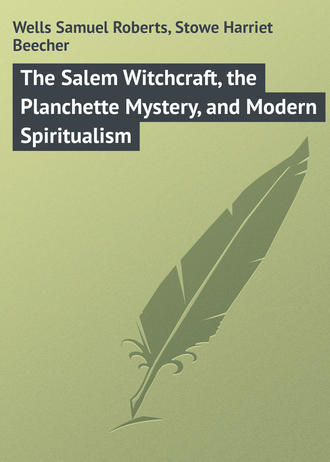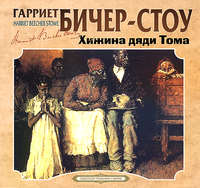 полная версия
полная версияThe Salem Witchcraft, the Planchette Mystery, and Modern Spiritualism
In the early days of the arts of life it is usual for the separate transactions of each day to be slow and cumbrous; but the experience of life may be rapid nevertheless. While traveling was a rough jog-trot, and forest-land took years to clear, and the harvest weeks to gather, property grew fast, marriages were precipitate and repeated, one generation trod on the heels of another, and the old folks complained that The Enemy made rapid conquest of the new territory which they had hoped he could not enter. When any work – of house-building, or harvesting, or nutting, or furnishing, or raising the wood-pile – had to be done, it was secured by assembling all the hands in the neighborhood, and turning the toil into a festive pleasure. We have all read of such “bees” in the rural districts of America down to the present day; and we can easily understand how the “goodmen” and “goodies” watched for the good and the evil which came out of such celebrations – the courtship and marriage, and the neighborly interest and good offices on the one hand, and the evil passions from disappointed hopes, envy, jealousy, tittle-tattle, rash judgment, and slander on the other. Much that was said, done, and inferred in such meetings as these found its way long afterward into the Tragedy at Salem. Mr. Upham depicts the inner side of the young social life of which the inquisitorial meeting-house and the courts were the black shadow:
“The people of the early colonial settlements had a private and interior life, as much as we have now, and the people of all ages and countries have had. It is common to regard them in no other light than as a severe, somber, and pleasure-abhorring generation. It was not so with them altogether. They had the same nature that we have. It was not all gloom and severity. They had their recreations, amusements, gayeties, and frolics. Youth was as buoyant with hope and gladness, love as warm and tender, mirth as natural to innocence, wit as sprightly, then as now. There was as much poetry and romance; the merry laugh enlivened the newly opened fields, and rang through the bordering woods as loud, jocund, and unrestrained as in these older and more crowded settlements. It is true that their theology was austere, and their policy, in Church and State, stern; but, in their modes of life, there were some features which gave peculiar opportunity to exercise and gratify a love of social excitement of a pleasurable kind.” (Vol. i. p. 200.)
Except such conflicts as arose about the boundaries of estates when the General Court was remiss in making and enforcing its decisions, the first and greatest strifes related to Church matters and theological doctrines. The farmers had more lively minds, better informed as to law, and more exercised in reasoning and judging than their class are usually supposed to have; for there never was a time when lawsuits were not going forward about the area and the rights of some landed property or other; and intelligent men were called on to follow the course of litigation, if not to serve the community in office. Thus they were prepared for the strife when the operation of the two Churches pressed for settlement.
TROUBLE IN THE CHURCHThe farmers in the rural district thenceforward to be called “Salem Village,” desired to have a meeting-house and a minister of their own; but the town authorities insisted on taxing them for the religious establishment in Salem, from which they derived no benefit. In 1670, twenty of them petitioned to be set off as a parish, and allowed to provide a minister for themselves. In two years more the petition was granted, as a compromise for larger privileges; but there were restrictions which spoiled the grace of such concession as there was. One of these restrictions was that no minister was to be permanently settled without the permission of the old Church to proceed to his ordination. Endless trouble arose out of this provision. The men who had contributed the land, labor, and material for the meeting-house, and the maintenance for the pastor, naturally desired to be free in their choice of their minister, while the Church authorities in Salem considered themselves responsible for the maintenance of true doctrine, and for leaving no opening for Satan to enter the fold in the form of heresy, or any kind or degree of dissent. Their fathers, the first settlers, had made the colony too hot for one of their most virtuous and distinguished citizens, because he had views of his own on Infant Baptism; they had brought him to judgment, magistrate and church member as he was, for not having presented his infant child at the font; he had sold his estates and gone away. If such a citizen as Townsend Bishop was thus lost to their society, how could the guardians of religion surrender their control over any church or pastor within their reach? They had spiritual charge of a community which had made its abode on the American shore for the single purpose of living its own religious life in its own way; and no dissent or modification from within could be permitted, any more than intrusion or molestation from without. Between the ecclesiastical view on the one hand, and the civil view on the other, there was small chance of harmony between town and village, or between pastor, flock, and the overseers of both. The great point on which they were all agreed was that they were all in special danger from the extreme malice of Satan, who, foiled in Puritan England, was bent on revenge in America, and was visibly and audibly present in the settlement, seeking whom he might devour.
Quarreling began with the appearance of the first minister, a young Mr. Bayley, who was appointed from year to year, but never ordained the pastor till 1679, when the authorities of Salem tried to force him upon the people of Salem Village in the face of strong opposition. The farmers disregarded the orders issued from the town, and managed their religious affairs by general meetings of their own congregation; and at length Mr. Bayley retired, leaving the society in a much worse temper than he had found on his arrival. A handsome gift of land was settled upon him, in acknowledgment of his services; he quitted the ministry, and practiced medicine in Roxbury till his death, nearly thirty years afterward.
REV. MR. BURROUGHSHis partisans were enemies of his successor, of course. Mr. Burroughs was a man of even distinguished excellence in the pastoral relation, in days when risks from Indians made that duty as perilous as the career of the soldier in war time; but his flock were divided, church business was neglected, he was allowed to fall into want. He withdrew, was recalled to settle accounts, was arrested for debt in full meeting – the debt being for the funeral expenses of his wife – was absolved from all blame under the cruel neglect he had experienced – and left the Village. Before he could hear in his remote home in Maine what was doing at Salem in the first days of the Witch Tragedy, he was summoned to his old neighborhood, was charged with sorcery on the most childish and absurd testimony conceivable, and executed in August, 1692. One of the witnesses – a young girl morbid in body and mind – poured out her remorse to him the day before his death. He, believing her a victim of Satan, forgave her, prayed with her, and died honored and beloved by all who were not under the curse of the bigotry of the time.
DEODAT LAWSONThe third minister was one Deodat Lawson, who is notable – besides his learning – for his Sermon on the Devil, and for some mournful mystery about his end. Of his last days there is nothing known but that there was something woeful in them; but his sermon, preached at the commencement of the outbreak in Salem, remains to us. It was published in America, and then widely circulated in England. It met the popular craving for light about Satan and his doings; and thus, between its appropriateness to the time and occasion, and the learning and ability which it manifested, it produced an extraordinary effect in its day. In ours it is an instructive evidence of the extent to which “knowledge falsely so called” may operate on the mind of society, in the absence of science, and before the time has arrived for a clear understanding of the nature of knowledge and the conditions of its attainment. Mr. Lawson bore a part in the Salem Tragedy, and then went to England, where we hear of him from Calamy as “the unhappy Mr. Deodat Lawson,” and he disappears.
PARRIS – A MALIGNANTThe fourth and last of the ministers of Salem Village, before the Tragedy, was the Mr. Parris who played the most conspicuous part in it. He must have been a man of singular shamelessness, as well as remarkable selfishness, craft, ruthlessness, and withal imprudence. He began his operations with sharp bargaining about his stipend, and sharp practice in appropriating the house and land assigned for the use of successive pastors. He wrought diligently under the stimulus of his ambition till he got his meeting-house sanctioned as a true church, and himself ordained as the first pastor of Salem Village. This was in 1689. He immediately launched out into such an exercise of priestly power as could hardly be exceeded under any form of church government; he set his people by the ears on every possible occasion and on every possible pretense; he made his church a scandal in the land for its brawls and controversies; and on him rests the responsibility of the disease and madness which presently turned his parish into a hell, and made it famous for the murder of the wisest, gentlest, and purest Christians it contained. [This man Parris must have had an inferior intellect, small Conscientiousness, Benevolence, and Veneration; large Firmness, Self-Esteem, Combativeness, Destructiveness, and Acquisitiveness.]
A PROTEAN DEVILBefore we look at his next proceeding, however, we must bring into view one or two facts essential to the understanding of the case. We have already observed on the universality of the belief in the ever-present agency of Satan in that region and that special season. In the woods the Red Men were his agents – living in and for his service and his worship. In the open country, Satan himself was seen, as a black horse, a black dog, as a tall, dark stranger, as a raven, a wolf, a cat, etc. Strange incidents happened there as everywhere – odd bodily affections and mental movements; and when devilish influences are watched for, they are sure to be seen. Everybody was prepared for manifestations of witchcraft from the first landing in the Bay; and there had been more and more cases, not only rumored, but brought under investigation, for some years before the final outbreak.
This suggests the next consideration: that the generation concerned had no “alternative” explanation within their reach, when perplexed by unusual appearances or actions of body or mind. They believed themselves perfectly certain about the Devil and his doings; and his agency was the only solution of their difficulties, while it was a very complete one. They thought they knew that his method of working was by human agents, whom he had won over and bound to his service. They had all been brought up to believe this; and they never thought of doubting it.
STATE OF PHYSIOLOGYThe very conception of science had then scarcely begun to be formed in the minds of the wisest men of the time; and if it had been, who was there to suggest that the handful of pulp contained in the human skull, and the soft string of marrow in the spine, and cobweb lines of nerves, apparently of no more account than the hairs of the head, could transmit thoughts, emotions, passions – all the scenery of the spiritual world! For two hundred years more there was no effectual recognition of anything of the sort. At the end of those two centuries anatomists themselves were slicing the brain like a turnip, to see what was inside it, – not dreaming of the leading facts of its structure, nor of the inconceivable delicacy of its organization. After half a century of knowledge of the main truth in regard to the brain, and nearly that period of study of its organization, by every established medical authority in the civilized world, we are still perplexed and baffled at every turn of the inquiry into the relations of body and mind. How, then, can we make sufficient allowance for the effects of ignorance in a community where theology was the main interest in life, where science was yet unborn, and where all the influences of the period concurred to produce and aggravate superstitions and bigotries which now seem scarcely credible?
[The reviewer appears to be a half believer in Phrenology, and yet unwilling to acknowledge his indebtedness to its teachers for the light he has received in the organization and phenomena of the brain.]
WILLIAM PENN AS A PRECEDENTThere had been misery enough caused by persecutions for witchcraft within living memory to have warned Mr. Parris, one would think, how he carried down his people into those troubled waters again; but at that time such trials were regarded by society as trials for murder are by us, and not as anything surprising except from the degree of wickedness. William Penn presided at the trial of two Swedish women in Philadelphia for this gravest of crimes; and it was only by the accident of a legal informality that they escaped, the case being regarded with about the same feeling as we experienced a year or two ago when the murderess of infants, Charlotte Winsor, was saved from hanging by a doubt of the law. If the crime spread – as it usually did – the municipal governments issued an order for a day of fasting and humiliation, “in consideration of the extent to which Satan prevails amongst us in respect of witchcraft.” Among the prosecutions which followed on such observances there was one here and there which turned out, too late, to have been a mistake. This kind of discovery might be made an occasion for more fasting and humiliation; but it seems to have had no effect in inducing caution or suggesting self-distrust. Mr. Parris and his partisans must have been aware that on occasion of the last great spread of witchcraft, the magistrates and the General Court had set aside the verdict of the jury in one case of wrongful accusation, and that there were other instances in which the general heart and conscience were cruelly wounded and oppressed, under the conviction that the wisest and saintliest woman in the community had been made away with by malice, at least as much as mistaken zeal.
The wife of one of the most honored and prominent citizens of Boston, and the sister of the Deputy Governor of Massachusetts, Mrs. Hibbins, might have been supposed safe from the gallows, while she walked in uprightness, and all holiness and gentleness of living. But her husband died; and the pack of fanatics sprang upon her, and tore her to pieces – name and fame, fortune, life, and everything. She was hanged in 1656, and the farmers of Salem Village and their pastor were old enough to know, in Mr. Parris’ time, how the “famous Mr. Norton,” an eminent pastor, “once said at his own table” – before clergymen and elders – “that one of their magistrates’ wives was hanged for a witch, only for having more wit than her neighbors;” and to be aware that in Boston “a deep feeling of resentment” against her persecutors rankled in the minds of some of her citizens; and that they afterward “observed solemn marks of Providence set upon those who were very forward to condemn her.” The story of Mrs. Hibbins, as told in the book before us, with the brief and simple comment of her own pleading in court, and the codicil to her will, is so piteous and so fearful, that it is difficult to imagine how any clergyman could countenance a similar procedure before the memory of the execution had died out, and could be supported in his course by officers of his church, and at length by the leading clergy of the district, the magistrates, the physicians, “and devout women not a few.”
[Here are evidences of large Cautiousness, fear, and timidity, with the vivid imagination of untrained childhood.]
PHENOMENA OF WITCHERYIn the interval between the execution of Mrs. Hibbins and the outbreak at Salem an occasional breeze arose against some unpopular member of society. If a man’s ox was ill, if the beer ran out of the cask, if the butter would not come in the churn, if a horse shied or was restless when this or that man or woman was in sight; and if a woman knew when her neighbors were talking about her (which was Mrs. Hibbins’ most indisputable proof of connection with the devil), rumors got about of Satanic intercourse; men and women made deposition that six or seven years before, they had seen the suspected person yawn in church, and had observed a “devil’s teat” distinctly visible under his tongue; and children told of bears coming to them in the night, and of a buzzing devil in the humble-bee, and of a cat on the bed thrice as big as an ordinary cat. But the authorities, on occasion, exercised some caution. They fined one accused person for telling a lie, instead of treating his bragging as inspiration of the devil. They induced timely confession, or discovered flaws in the evidence, as often as they could; so that there was less disturbance in the immediate neighborhood than in some other parts of the province. Where the Rev. Mr. Parris went, however, there was no more peace and quiet, no more privacy in the home, no more harmony in the church, no more goodwill or good manners in society.
As soon as he was ordained he put perplexing questions about baptism before the farmers, who rather looked to him for guidance in such matters than expected to be exercised in theological mysteries which they had never studied. He exposed to the congregation the spiritual conflicts of individual members who were too humble for their own comfort. He preached and prayed incessantly about his own wrongs and the slights he suffered, in regard to his salary and supplies; and entered satirical notes in the margin of the church records; so that he was as abundantly discussed from house to house, and from end to end of his parish, as he himself could have desired. In the very crisis of the discontent, and when his little world was expecting to see him dismissed, he saved himself, as we ourselves have of late seen other persons relieve themselves under stress of mind and circumstances, by a rush into the world of spirits.
Four years previously, a poor immigrant, a Catholic Irishwoman, had been hanged in Boston for bewitching four children, named Goodwin – one of whom, a girl of thirteen, had sorely tried a reverend man, less irascible than Mr. Parris, but nearly as excitable. The tricks that the little girl played the Reverend Cotton Mather, when he endeavored to exorcise the evil spirits, are precisely such as are familiar to us, in cases which are common in the practice of every physician. If we can not pretend to explain them – in the true sense of explaining – that is, referring them to an ascertained law of nature, we know what to look for under certain conditions, and are aware that it is the brain and nervous system that is implicated in these phenomena, and not the Prince of Darkness and his train. Cotton Mather had no alternative at his disposal. Satan or nothing was his only choice. He published the story, with all its absurd details; and it was read in almost every house in the Province. At Salem it wrought with fatal effect, because there was a pastor close by well qualified to make the utmost mischief out of it.
[In cases of hysteria, the phenomena are sometimes so remarkable, that one is disposed to attribute their cause to influences beyond nature.]
PARRIS AND HIS “CIRCLE.”Mr. Parris had lived in the West Indies for some years, and had brought several slaves with him to Salem. One of these, an Indian named John, and Tituba his wife, seem to have been full of the gross superstitions of their people, and of the frame and temperament best adapted for the practices of demonology. In such a state of affairs the pastor actually formed, or allowed to be formed, a society of young girls between the ages of eight and eighteen to meet in his parsonage, strongly resembling those “circles” in the America of our time which have filled the lunatic asylums with thousands of victims of “spiritualist” visitations. It seems that these young persons were laboring under strong nervous excitement, which was encouraged rather than repressed by the means employed by their spiritual director. Instead of treating them as the subjects of morbid delusion, Mr. Parris regarded them as the victims of external diabolical influence; and this influence was, strangely enough, supposed to be exercised, on the evidence of the children themselves, by some of the most pious and respectable members of the community.
We need not describe the course of events. In the dull life of the country, the excitement of the proceedings in the “circle” was welcome, no doubt; and it was always on the increase. Whatever trickery there might be – and no doubt there was plenty; whatever excitement to hysteria, whatever actual sharpening of common faculties, it is clear that there was more; and those who have given due and dispassionate attention to the processes of mesmerism and their effects can have no difficulty in understanding the reports handed down of what these young creatures did, and said, and saw, under peculiar conditions of the nervous system. When the physicians of the district could see no explanation of the ailments of “the afflicted children” but “the evil hand,” no doubt could remain to those who consulted them of these agonies being the work of Satan. The matter was settled at once. But Satan can work only through human agents; and who were his instruments for the affliction of these children? Here was the opening through which calamity rushed in; and for half a year this favored corner of the godly land of New England was turned into a hell. The more the children were stared at and pitied, the bolder they grew in their vagaries, till at last they broke through the restraints of public worship, and talked nonsense to the minister in the pulpit, and profaned the prayers. Mr. Parris assembled all the divines he could collect at his parsonage, and made his troop go through their performances – the result of which was a general groan over the manifest presence of the Evil One, and a passionate intercession for “the afflicted children.”
[These afflicted children of Salem, in 1690, were kindred to the numerous “mediums” of 1869. In the former, ignorance ascribed their actions and revelations to the devil, who bewitched certain persons. Now, we simply have the more innocent “communications” from where and from whom you like.]
THE INQUISITIONS. – SARAH GOODThe first step toward relief was to learn who it was that had stricken them; and the readiest means that occurred was to ask this question of the children themselves. At first, they named no names, or what they said was not disclosed; but there was soon an end of all such delicacy. The first symptoms had occurred in November, 1691; and the first public examination of witches took place on the 1st of March following. We shall cite as few of the cases as will suffice for our purpose; for they are exceedingly painful; and there is something more instructive for us in the spectacle of the consequences, and in the suggestions of the story, than in the scenery of persecution and murder.
In the first group of accused persons was one Sarah Good, a weak, ignorant, poor, despised woman, whose equally weak and ignorant husband had forsaken her, and left her to the mercy of evil tongues. He had called her an enemy to all good, and had said that if she was not a witch, he feared she would be one shortly. Her assertions under examination were that she knew nothing about the matter; that she had hurt nobody, nor employed anybody to hurt another; that she served God; and that the God she served was He who made heaven and earth. It appears, however, that she believed in the reality of the “affliction;” for she ended by accusing a fellow-prisoner of having hurt the children. The report of the examination, noted at the time by two of the heads of the congregation, is inane and silly beyond belief; yet the celebration was unutterably solemn to the assembled crowd of fellow-worshipers; and it sealed the doom of the community, in regard to peace and good repute.
A CHILD WITCHMrs. Good was carried to jail. Not long after her little daughter Dorcas, aged four years, was apprehended at the suit of the brothers Putnam, chief citizens of Salem. There was plenty of testimony produced of bitings and chokings and pinchings inflicted by this infant; and she was committed to prison, and probably, as Mr. Upham says, fettered with the same chains which bound her mother. Nothing short of chains could keep witches from flying away; and they were chained at the cost of the state, when they could not pay for their own irons. As these poor creatures were friendless and poverty-stricken, it is some comfort to find the jailer charging for “two blankets for Sarah Good’s child,” costing ten shillings.









